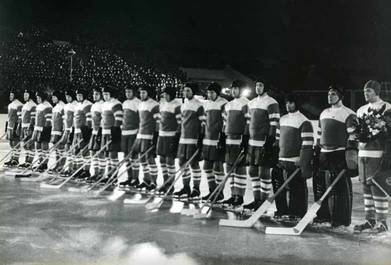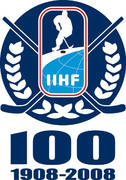Story #71
March 5, 1957 — Moscow, Russia
The Soviet Union shocked the hockey world by winning the 1954 World Championship in their first international appearance. Two years later, the Vsevolod Bobrov-led CCCP team won Olympic gold in Cortina. The decision to hold the 1957 World Championship in Moscow was made by the IIHF in recognition of the instant success of Soviet hockey.
When it was learned that neither Canada nor the United States were coming to Moscow, the hosts were unanimously considered the tournament favourites. Most of the games of the 24th World Championship were held in the newly built indoor Luzhniki Sports Palace. The last game of the round-robin format between the Soviet Union and Sweden was to be the gold medal game. The Swedes, led by players like Sven Tumba, Lasse Bjorn, Roland Stoltz and Nisse Nilsson, had won six straight games, while the Soviets had five wins and one tie, against Czechoslovakia.
Only three years earlier, the Soviet sports fans hade a very vague idea of ice hockey, which the authorities endorsed only in 1946. But after the successes of 1954 and 1956, ice hockey interest grew immensely. With the national team playing in an all-decisive gold medal game against Sweden, the demand for tickets was massive.
The tournament directorate realized that playing in the 14,000-seat Luzhniki Sports Palace would prevent many fans from attending the game. The decision was made to build a rink on the nearby Luzhniki soccer stadium. As this was Moscow in early March 1957 and the world had not yet been subjected to the term ‘global warming’, the organizers were not taking any major risks that it would be cold enough to sustain the ice.
The exact attendance figure will never be known, but as the teams took to the ice there were at least 50,000 (some say 55,000) fans. The game was a classic. The guests took a 2-0-lead in the first period, but the Soviets scored four goals in the second stanza making it 4-2 after two. Sweden got one back early in the third. With twelve minutes to go it was still 4-3 and the gold medals seemed destined to stay in Moscow. But then Swedish forward Eilert Maatta chased a loose puck in the right corner of the Soviet zone and cut to the goal, skating along the goal line.
With no one to pass to, Maatta saw that Russian goalie Nikolai Puchkov, anticipating a centering pass, had left a small gap between his pads and the goal post. The Swede, a right-handed shooter, went for the backhander and the puck found the small opening left by Puchkov.
The Swedes hung on, and the 4-4-tie gave Tre Kronor their second World title. Despite the fact that the Soviets didn’t win gold, they started a streak that would see them go undefeated on Moscow ice in World Championship competition for 41 games during a span of 50 years. The streak was broken on May 12, 2007 when Finland became the first team to defeat the home team in Moscow in a World Championship game.
Unless the IIHF takes its flagship event outdoors again, the attendance record from the Luzhniki soccer stadium will never be broken. It was that game, on March 5, 1957, that established hockey as the sport of the masses in the Soviet Union.
As part of the IIHF's 100th anniversary celebrations, www.IIHF.com is featuring the 100 top international hockey stories from the past century (1908-2008). Starting now and continuing through the 2008 IIHF World Championships in Canada, we will bring you approximately three stories a week counting down from Number 100 to Number 11.
The Final Top 10 Countdown will be one of the highlights of the IIHF's Centennial Gala Evening in Quebec City on May 17, the day prior to the Gold Medal Game of the 2008 World Championship.
These are the criteria for inclusion on this list: First, the story has to have had a considerable influence on international hockey. Second, it has to have had either a major immediate impact or a long-lasting significance on the game. Third, although it doesn't necessarily have to be about top players, the story does have to pertain to the highest level of play, notably Olympics, World Championships, and the like. The story can be about a single moment — a goal, a great save, a referee's call — or about an historic event of longer duration — a game, series, tournament, or rule change.
|










